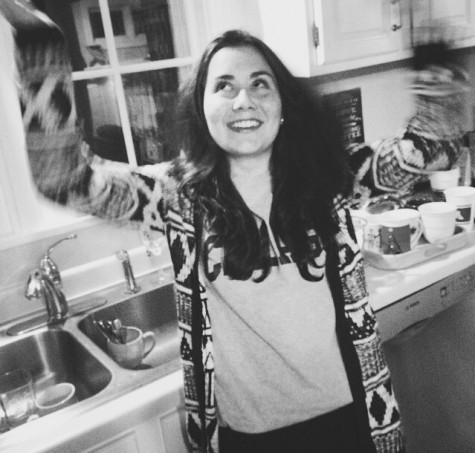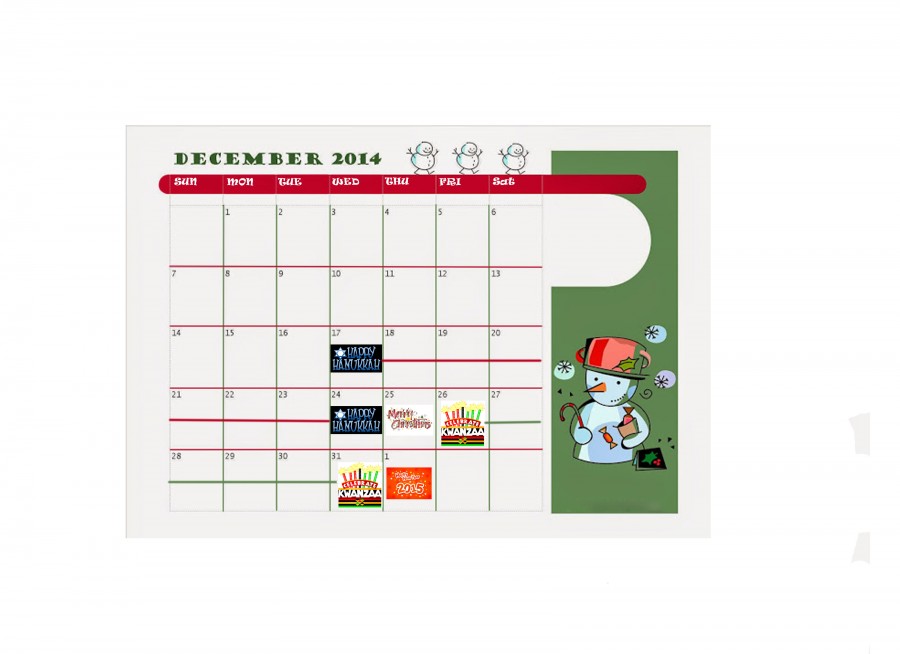The most wonderful time of the year
Bright lights, decked halls and boughs of holly are all trademark signs of the holiday buzz. Although the most commercialized here in the United States, Christmas hardly monopolizes these celebrations. Hanukkah, Kwanzaa and Ramadan/Eid al-fitr are all widely celebrated holidays that hold rich cultural and religious significance as well.
Hanukkah
Hanukkah, observed by the Jewish religion, is a Hebrew word translating to ‘Establishing’ or ‘Dedication’ (of the Temple of Jerusalem) and is also known as the Festival of Lights. According to History.com’s article the traditions surrounding this holiday go back thousands of years to around 165 B.C., when the Maccabees revolted against Antiochus IV Epiphanes. Under Antiochus’ rule, the Jews had been persecuted and forced to make sacrifices to false gods. The rebellion was led by the high priest Mattathias and his five sons, Jochanan, Simeon, Eleazar, Jonathan and Judah. Judah, who took his father’s place after his death, was the one to reinstate the Temple. In order to do this, however, the Jews needed pure, undefiled olive oil to burn in the Temple’s menorah, a seven branched lamp made of solid gold. According to the Talmud, the central text of Rabbinic Judaism, even though there was only enough oil to burn for one night, it miraculously burned for eight. This gave enough time to prepare more oil in accordance to Judaism’s dietary laws, known as kosher. An eight day celebration and thanksgiving was declared by Jewish sages to commemorate this miracle. Although according to Jewish law it is actually one of the least important holidays, it has grown in popularity because of the proximity to Christmas. Today, personalized celebrations vary from family to family and culture to culture, just like every other holiday. Traditionally, fried food (preferably prepared in olive oil) are served. The Jewish Virtual Library gives their readers recipes for the popular potato pancakes (latkes), jam-filled doughnuts (pontshkes) and fritters (bimvelos). The original seven-branched menorah has been exchanged for a nine-branched menorah, and a candle is lit every night for eight nights, followed by a series of blessings and gift giving. Games such as dreidel are played, and traditional songs are sang. Unlike Christmas, it does not have a set date. This year, Hanukkah will begin on Dec 17, 2014 and continue until Dec 24, 2014.
Kwanzaa
Kwanzaa derives from the Swahili phrase “matunda ya kwanza” or “first fruits” and is a holiday celebrated by some African-Americans and Pan-Africans. Although the origins of harvest ceremonies have been traced to ancient Egypt and Nubia, History.com tells its readers that Kwanzaa, as most know it today, was instituted by Dr. Maulana Karenga in 1966. A professor of Black Studies at University of California, Long Beach, Dr. Karenga was disturbed by race riots in Los Angeles and was looking for a way to unite all African Americans together and tie in their pride to their African roots. He created a set of ideals called Nguzo Saba or ‘the seven principles’, with each principle being emphasized on a different day of Kwanzaa. The official Kwanzaa website gives these as follows:
- Umoja (unity)
- Kujichagulia (self determination)
- Ujima (collective work and responsibility)
- Ujamaa (cooperative economics)
- Nia (purpose)
- Kuumba (creativity)
- Imani (faith)
Each principle also comes with a symbol:
- Mazao (The Crops)
- Mkeka (The Mat)
- Kinara (The Candle Holder)
- Muhindi (The Corn)
- Mishumaa Saba (The Seven Candles)
- Kikombe cha Umoja (The Unity Cup)
- Zawadi (The Gifts)
- Bendera (The Flag)
Gifts are not a large part of this holiday and are mainly given to children, but must always include a book and a heritage symbol. The colors red, green and black are utilized throughout the seven days and decor is kept to traditional African items. Because it is a cultural, not religious, holiday, Kwanzaa is celebrated by Christians, Muslims, Jews and secular families alike. The festivities begin on Dec 26 and continue until Jan 1, also feature poetry, performance art, and the Kwanzaa Karamu (feast) on New Year’s Day.
Ramadan/Eid al-Fidr
Ramadan/Eid al-Fidr, although oftentimes grouped up with the above holidays, has a completely unrelated schedule and meaning. IslamCity.com tells its readers Ramadan has pagan roots in the Middle East to honor the moon god as early as second Century A.D., and derives from the Arabic word Ramad, literally meaning “hot month”, as it was originally observed in the summer. The Prophet Mohammed began to integrate these traditions into his own monotheistic teachings around 620 C.E, and it is now one of the most widely celebrated holidays in the world. Muslims around the globe participate annually in the Ramadan fast, which falls during the ninth month of the Islamic calendar and is considered the holiest month of the year. Food is not to be eaten when the sun is up, and evenings/early mornings are spent in spiritual reflection, family meals and readings from the Quran (pregnant women and the sick are excused from the fast). Along with observing Ramadan, believing in the one Allah, giving to the poor, a pilgrimage to Mecca, and praying five times a day, make up the Five Pillars of Islam. MuslimMatters.org says that it is meant to have both physical and spiritual effects, including an increased dependence on God, reminding oneself of the poor, and to atone for past sins. Following the completion of Ramadan is the feast Eid al-Fidr, first celebrated in 624 C.E. by the Prophet Muhammad and his companions after the victory of the battle of Jang-e-Badar. It is a day of merriment, wearing new clothes, stringing lights, and naturally, breaking the fast. Many Muslims recite the takbir, a declaration of faith, on the way to the mosque and give special charitable contributions known as Zakat al-Fitr. A common greeting is “Eid Mubarak!” which means “Have a blessed Eid!” This year, Ramadan will be observed from June 18, 2015 through July 17, 2015.
Although they come from different parts of the world and celebrate different events, one thing is clear: Christmas, Ramadan/Eid, Kwanzaa and Hanukkah all have much more in common than they do differences. The importance of gratitude, family, not to mention all the food, are central themes. They put the everyday worries and complaints into perspective and help everyone focus on what is truly important. These holidays remind the world that despite all of its bleakness, there is always a reason to celebrate.

I am an OHS Senior who has been successful at remaining slightly above average in all of my activities, including National Honors Society, cross country,...


